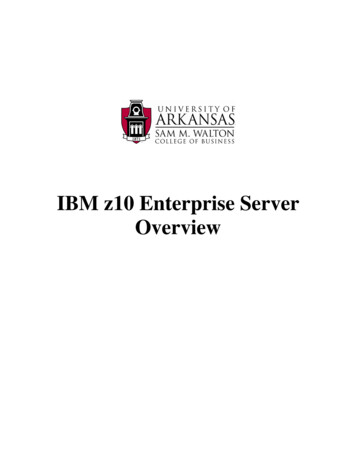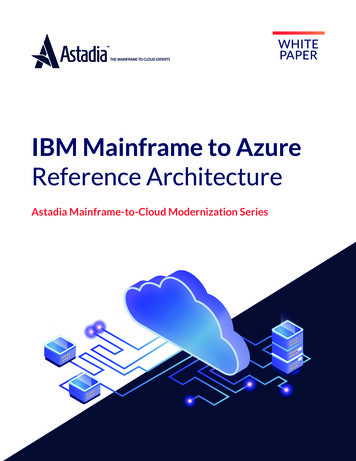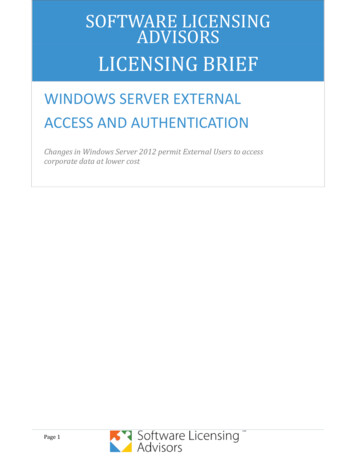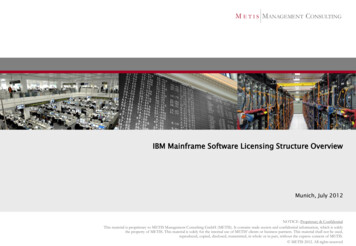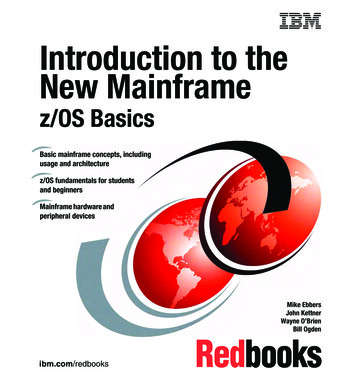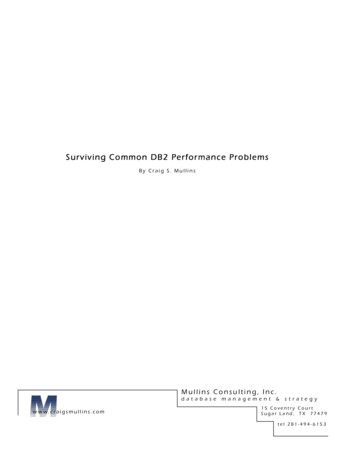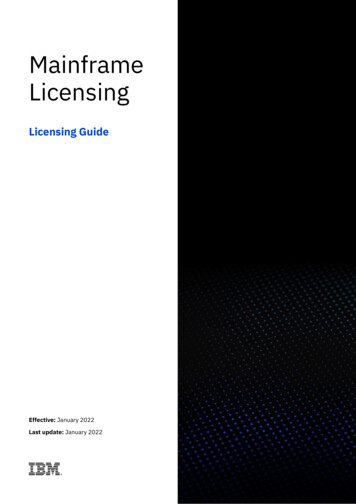
Transcription
MainframeLicensingLicensing GuideEffective: January 2022Last update: January 2022
2ContentsContentsOverview 3Key Terms 3Introduction 4Detail 4Scenarios and FAQs 12Further Reading 13Mainframe
3OverviewMainframeOverviewKey TermsThis document provides an overview of the mostcommon approaches used by IBM to licensesoftware on the mainframe (also referred to aszSeries and System Z). Mainframe licensing canbe very different from the licensing of distributedsoftware and there are many small but significantvariations which make it complex to apply inpractice.The following terms are used throughout thisdocument and are fundamental to understandingits contents. This is not an exhaustive list, andsome concepts may be discussed in other licensingguides or rely on assumed knowledge.This guide provides information on the mostcommon situations only.An agreement setting out licensing terms for certain IBMofferings. In particular, the mainframe software that ismeasured on a Monthly License Charge (“MLC”) basis islicensed under the ICA.This guide is intended as a general licensingknowledge resource. While it may explorescenarios, it is not intended to provide advice forspecific customer circumstances. Always consultyour IBM representative should you have anyquestions or concerns about your mainframelicensing.IBM Customer Agreement (“ICA”)International Program License Agreement (“IPLA”)An agreement setting out the base terms for all IBMprograms licensed under PA, PAE and certain mainframeprograms. It is available here.MIPSA measurement of raw processing capacity. It stands for“Millions of Instructions Per Second”. It is used as thebasis for calculating MSUs.Monthly License Charge (“MLC”)A way of licensing IBM programs on the mainframewhich involves reporting and paying for use monthly.MSUA measurement of processing capacity on themainframe. It stands for “Millions of Service Units perHour”. Each physical mainframe is given a MSU rating.Parallel SysplexThe linking of two or more physical mainframes to formone, larger logical machine. Workload is shared acrossthis logical machine to benefit from lower workloadpricing; the price per MSU decreases as the size ofthe machine increases. There are criteria to qualifyfor Parallel Sysplex, one of which is that a significantamount (defined as 50% or more) of the entire workloadof the combined machines must be shared between theconnected machines.Sub-Capacity Reporting Tool (“SCRT”)A tool used to measure Sub-Capacity licenserequirements for MLC software on the mainframe.
4IntroductionIntroductionIBM licenses mainframe software under twoprimary licensing models - Monthly License Charge(“MLC”) and One Time Charge (“OTC”) underthe International Program License Agreement(“IPLA”).As a rule of thumb, the mainframe operatingsystems (z/OS and OS/390) are licensed underthe MLC licensing model, while applications thatmanage, control, and support the mainframeenvironment are licensed under either MLC or OTC(such as IBM DB2 Utilities). Some products areavailable under both MLC and OTC.It is also important to note that aside fromdifferences in licensing models there are alsospecific license metrics which only exist formainframe programs.MainframeDetailAn Overview of Mainframe SoftwareLicensingOperating SystemsThe mainframe uses operating systems that mightbe unfamiliar to individuals more accustomedto the ‘distributed’ world (that is, servers anddesktops where Microsoft Windows Server, IBMAIX and Linux distributions are widely seen).The mainframe operating systems are z/OS, Linux,z/VM, z/VSE and z/TPF. Multiple operating systemscan run on a single mainframe, which allowsclients to select the best platform combination fortheir workload.Each operating system has its own unique benefits,set out in more detail here.Particularly notable is z/VM, which is IBM’svirtualization technology for mainframe and allowsclients to obtain better value for their mainframeworkloads.ApplicationsThere is a large catalog of applications that run onmainframe. Some of IBM’s most common productsare available for mainframe and distributed.Read more about the applications that run onmainframes here.The MLC and IPLA licensing models are explainedin more detail below.
5DetailMainframeLicense TypesThe different ways of licensing mainframe software are discussed later in this guide. The table belowsummarizes the various categories of software and S&S considerations:CategoryContractS&SMLCIBM CustomerAgreement (ICA) orCustomer RelationshipAgreement (CRA)Included in themonthly licensechargeInternational ProgramLicense Agreement(IPLA)Must be purchasedseparately. First yearis not included in theinitial purchaseOTC (IPLA)OTC (PassportAdvantage)OTC(“zDistributed”)IPAA or IPAEAIPLAIPAA or IPAEAIPLAFirst year includedin initial licensepurchase. Subsequentyears purchased asa separate S&S partnumber. All deployedquantities on a PASite Number mustbe renewed, or noneat all.As with PassportAdvantageExample PartNumber5655X015655X02Example PartDescriptionSterlingConnect:Direct z/OSSterlingConnect:Direct z/OSS&SD0J1KLLIBM Sterling Connect:Direct StandardEdition SimultaneousSession License SW Subscription &Support 12 MonthsD0J2DLLIBM Sterling Connect:Direct StandardEdition for Linuxon IBM z SystemsSimultaneousSession License SW Subscription &Support 12 Months
6DetailMainframeLicense AgreementsThe applicable license agreements depend upon whether the software is licensed under MLC or IPLA. Thetable below summarizes the relevant license agreements for each type of mainframe software:ProductAgreement(s)Mainframe hardwareIBM Customer Agreement (“ICA”) or Customer Relationship Agreement (“CRA”)MLC softwareIBM Customer Agreement (“ICA”) or Customer Relationship Agreement (“CRA”)International Program License Agreement (“IPLA”)And/OrIPLA softwareIBM Passport Advantage Agreement (“IPAA”) or IBM Passport Advantage Express Agreement(“IPAEA”)AndInternational Agreement for Acquisition of Software Maintenance (“IAASM”)There are some important differences between programs licensed directly under IPLA and those licensedunder Passport Advantage (IPAA or IPAEA). The table below sets out some of the key ones:IPLAPassport AdvantageIs S&S included with the purchaseof a perpetual license?NoYesDo I need to buy S&S?NoNo, except for the first year as it comesincluded with the ‘base’ licenseHow much of my S&S do I need tomaintain?Your entire purchased entitlementmust be maintained, or noneAll the licenses used within an individualPA site must be maintained, or none
7DetailMainframeThe MLC Licensing ModelFull-CapacityFull-Capacity measurement is a fixed monthlyprice based on the MSU rating of the physicalmainframe. Pricing is fixed regardless of use.This is IBM’s oldest and simplest, but leastflexible, pricing model. However, its simplicitybrings certainty: if your environment andsoftware remain unchanged month to monthyour MLC invoice each month will be the same.The MLC licensing model applies to the operatingsystem and to some applications such as IBM DB2,IBM CICS, IBM IMS, and IBM WebSphere MQ.It is based on a monthly fee for the use of theprogram. Support and maintenance (known asSoftware & Subscription or “S&S”) is included inthis monthly fee.There are three key aspects to the MLC:–The approach to measurement,–the measurement of usage, and–the pricing plan.Sub-CapacityIBM introduced Sub-Capacity licensing over 20years ago. This is based on peak usage duringthe month rather than the physical capacity ofthe mainframe. The concept is like VirtualizationCapacity used for Distributed software, howeverfor the mainframe peak use is measured on arolling 4 hourly average (“R4HA”, sometimesreferred to as “4RHA”) basis rather than at asingle point in time.The approach to measurementUse-based metricsUse-based metrics, such as Authorized User, arecalculated in the way described in the LicenseInformation document for the program.To benefit from Sub-Capacity licensing, you mustrun a tool called IBM Sub-Capacity ReportingTool (“SCRT”) on the mainframe environment.All mainframe environments, including disasterrecovery environments, must be monitored. SCRTwill measure the R4HA use over time. Reportsfrom SCRT detailing the R4HA must be shared withIBM each month, and IBM uses these reports tocalculate the MLC invoice.Capacity-based metricsThere are three approaches to measuring capacitybased license metrics that apply to mainframelicensing under MLC (see Figure 1). All models arecurrently available for purchase.While SCRT needs to be run on disaster recoveryenvironments, these environments can be excludedfrom the report before sharing it with IBM.Figure 1: The three primary MLC measurement modelsFull CapacitySub-Capacity(R4HA)Tailored Fit Pricing
8DetailMainframeTailored Fit Pricing (“TFP”)Capacity cappingThis is IBM’s newest measurement method,introduced in May 2019. It is a true use-basedcapacity model. You are only charged for youractual use of the software, and this use ismeasured on a minute-by-minute basis.The number of MSUs required for a logical partition(LPAR) is defined by reference to the hard cap,not the soft cap, that is, the cap managed at theProcessor Resource/System Manager level, not theWorkload Manager level.There are several criteria that must be met toqualify for TFP. One of the key criteria is that 12months of historic Sub-Capacity reporting mustbe available to allow IBM to analyze historic useand calculate a price per MSU, and to provide apredictable discounted price for future growth inworkloads.MIPsOnce qualified for TFP you no longer need to beconcerned about how much processing capacityyour mainframe workloads are using, and all formsof processor capacity capping can be removed.Minute-by-minute usage is calculated by SCRT.Reports from SCRT are required to be submitted toIBM every month.The measurement of usage – MSUs andMIPsDepending on the applicable measurementapproach for your mainframe, the MLC iscalculated based on the number of MSUs or thenumber of MIPS.MSUsFundamentally, the MSU metric (which stands forMillions of Service Units per hour) is a measure ofthe amount of processing work a computer canperform in one hour. Each mainframe is given aMSU rating which can be used for Full-Capacitypurposes; for Sub-Capacity purposes SCRTcalculates the MSUs consumed on a rolling fourhourly basis for you.Charges are priced per machine but it is possibleto aggregate multiple machines into one machinefor pricing purposes through a process known asCountry Multiplex Pricing (“CMP”). The use of CMPis subject to eligibility requirements and terms andconditions. You can learn more about CMP here.To learn more about MSUs and how SCRTcalculates MSU usage, see here.MIPs (or Millions of Instructions per Second) arealso used to define the capacity of the mainframe.This metric is mostly encountered in olderproducts where the focus was on measuring therate at which a processor executes instructions.Although the name suggests otherwise, MIPsare not actually a measurement of the number ofinstructions per second; the value is derived fromnumbers published by IBM in the Large SystemPerformance Reference (“LPSR”) table.The LPSR table is described in more detail atthe following link: 60.nsf/pages/lsprindex?OpenDocument
9DetailMainframeThe pricing planThere are various pricing plans that determine how much each MSU or MIP costs to license. Each model isslightly different and is based on the type of mainframe and the type of workloads that are run on the machine.Note that not all pricing plans are available to all customers as some have qualifying criteria that must be met.The key pricing plans are summarized in Table 1 below:Table 1: The key MLC software pricing modelsPricing PlanAbbr.DescriptionAdvanced Workload LicenseChargeAWLCUsed for larger hardware, for example specific machines running theoperating systems z/OS or z/TPF in z/ArchitectureAdvanced Entry WorkloadLicense ChargeAELCUsed for smaller hardware, for example specific machines andstandalone z14 serversNew Application License ChargeszNALCUsed for z/OS virtual environments (or “LPARs”) where a qualified “newworkload” application is running. Essentially, this model is used toincentivize the addition of new workloads to existing environments byoffering reduced pricing.There are many types of new workload and you can discuss with yourIBM representative whether your application qualifies as a new workload.Midrange Workload ChargesParallel SysplexMWLCUsed for 15 specific products and the z/VSE (or later) operating system.A method of aggregating multiple physical mainframes together to formone larger logical system. This allows you to achieve lower price-perValue Unit.This is not a comprehensive list of metrics but covers the most widely used ones; for other pricing models suchas zSeries Entry License Charges (zELC) and older metrics such as Workload License Charges (WLC) pleaserefer to this page.To see the monthly invoices that have been raised for your use of MLC programs, go to www.ibm.com/support/customer/invoices and log in with your IBM ID.
10 DetailThe OTC licensing modelThere are three types of OTC programs describedin turn below.Programs licensed directly under IPLASome mainframe software is licensed underthe International Program License Agreement(“IPLA”). IPLA entitlements for mainframesoftware are listed in “Shopz”, the mainframeequivalent of Passport Advantage Online.Software licenses are acquired for IPLA mainframesoftware in the same way as for distributed (thatis, Passport Advantage) software but there are afew key differences:1. The first year of Support and Subscription(S&S) is not included in the initial purchaseof a perpetual license. S&S is purchasedseparately.2. S&S must be purchased for ALL of themainframe environments. This is slightlydifferent from Passport Advantage termswhich allow you to maintain S&S only for thelicenses you actively use.3. You must have sufficient licenses to cover yourpeak use of the software.The initial purchase of a perpetual license underIPLA is often referred to as the One-Time Charge(“OTC”) in the mainframe context.Programs licensed under PassportAdvantageCertain IBM programs licensed under PassportAdvantage (an agreement which sits underIPLA) can be deployed on the mainframe. If youhave a license for the mainframe equivalent ofa distributed program, then you may use thisentitlement to license the use of the program on adistributed environment. Likewise, an entitlementto a distributed IBM program permits you to deployit on Linux on Z.As with other Passport Advantage entitlements,the first year of S&S is included in the initialpurchase of the base perpetual license.MainframezDistributedA subset of programs licensed under PA haveprogram names which specifically reference theirdesignation for mainframe deployment. These aresometimes referred to as “zDistributed” programs.The name of the software includes, for example,‘for Linux on z’ or ‘for Linux on z Systems’, whichdenotes a license specific to the mainframeenvironment.Value UnitsIt is common for OTC programs to be licensedby Value Units. In simple terms, value units arecalculated by counting the number of ‘resources’and applying a tiered discount. The most commonresource counted is MSUs.The conversion from resource to Value Unit isdetailed in a table known as a Value Unit Exhibit.Each exhibit is referred to by a number, forexample VUE001, VUE002 and so on. The full listof Value Unit Exhibits is located here.The relevant Value Unit Exhibit is documented inthe announcement letter for the program. You cansearch announcement letters here.To calculate the number of Value Units requiredfor your mainframe software, the following stepsshould be taken:1. Determine the required license capacity,measured in MSUs2. Sum up all the MSUs required based onthe relevant Full-Capacity or Sub-Capacitymeasurement method across your Enterprise.If you are eligible for Country Multiplex Prcing,you can aggregate the MSU requirementswithin each country.3. Convert the total MSUs to Value Units for eachcountry (if applicable) using the Value UnitExhibit for that program.You can find the Value Unit Converter Tool here.
11 DetailMainframeOther methods of measuring usageSome mainframe programs do not use MSUs or Value Units to measure their use. In such cases, the method todetermine the number of licenses required is documented in the License Information document or the LicenseProgram Specification document, which can be found by searching the IBM Documentation website.The table below gives a small number of examples that are frequently encountered:ProgramMeasurement MetricPSFPrinter Points – a measurement based on the speed of the printers the softwareis driving. Each printer is assigned a category based on its speed by reference to“impressions per minute”.The Printer Points for all connected printers are aggregated and the total numberof Printer Points determines the Usage Tier of PSF license that is required.Changes to the printer environment might therefore affect the Tier that you requireto license your PSF software with.Sterling ConnectConcurrent Sessions – the number of sessions that are simultaneously open.A session could be a user logging in, or it could be a session established betweendevices.DB2 ConnectUnlimited Editionfor System zCan be licensed either by MSU or Host Server. The way MSU is measured is slightlydifferent as detailed below.MSU: The licenses required will depend upon the MSU capacity of the LPAR towhich the installation is connected and installed. Tailored Fit Pricing minute-byminute usage does not apply.Host Server: each production DB2 for z/OS subsystem.
12 ScenariosScenariosService ProvidersIBM does not offer certain pricing andmeasurement options to Service Providers.Examples of these are:–Value Unit Exhibits (VUE)–Tailored Fit Pricing. Service Providers can,however, benefit from Sub-Capacity.PSF PrinterThe licenses initially acquired for this productreflects your printer environment at that time.However, as explained earlier in this guide, theoverall ‘Usage Tier’ that is applicable to the licenseyou need for PSF is the accumulation of all thePrinter Points assigned to your printers.Changes to your printer environment can oftencause the Usage Tier to change. In our experiencethe movement is generally to a higher tier, not alower one. Clients often forget to recalculate theirUsage Tier and inform IBM about any change ofUsage Tier.This often results in non-compliance when this ischecked as part of a licensing verification activity.It can easily be avoided by bearing the effect onUsage Tier in mind when adding, removing orupgrading printers in the mainframe environment.Sterling Connect:DirectWhen installing Sterling Connect:Direct it isimportant to double-check that you are installingthe correct product. Sterling Connect:Direct ismade available under more than one licensemetric. In audits it is often noticed that acustomer with a Simultaneous Session licensehas mistakenly installed the version of SterlingConnect:Direct which is licensed by MSU. Thiscreates a license exposure as the client does nothave any entitlement to MSUs for this product.MainframeFAQsWhat is the definition of Production?See the Backup policy for ICA (related to MLCsoftware) and the Backup policy for IPLA (relatingto OTC, OTC (Passport Advantage) and OTC(zDistributed) programs), both on the SoftwarePolicies page, for detailed definitions of what IBMconsiders to be Production. The core conceptdescribed in these documents is whether theprogram is ‘doing work’.Where can I learn more about Sub-CapacityReporting Tool (SCRT)?Please see the SCRT FAQ which is located here.How do I license disaster recovery or testing in amainframe environment?Sub-Capacity Reporting Tool (SCRT) is theapplication which IBM uses to measure the useof MLC software. It should be installed on LPARs,including but not limited to, Production, Test,Development and Disaster Recovery LPARs. Toavoid paying for licenses while performing DisasterRecovery testing it is possible to exclude thisworkload from the SCRT report. In addition, thereare certain types of LPARs which are not supportedby SCRT such as coupling configurations.
13 Further ReadingMainframeFurther ReadingAdvanced Entry Workload License Charges(AEWLC)A document defining and providing details of theAdvanced Entry Workload License Charges Y6LZXKAdvanced Workload License Charges (AWLC)A document defining and providing details of theAdvanced Workload License Charges pricing ountry Multiplex Pricing (“CMP”)A document defining and providing details of CountryMultiplex IBM Announcement LettersA searchable repository of IBM Announcement t.wssMidrange Workload License Charges (“MWLC”)A document defining and providing details of MidrangeWorkload License Overview of Value Unit ExhibitsA document defining and providing details of ValueUnit Exhibits, including VUE conversion NV5RDQXBParallel Sysplex License ChargesA document defining and providing details ParallelSysplex License SCRT User GuideA comprehensive user guide for the Sub CapacityReporting Tool celink/svc00100.nsf/pages/SCRTsc236845/ file/e0z3s127.pdfSCRT Process OverviewA page detailing the process for enabling sub-capacitypricing using the Sub Capacity Reporting Tool topic tooloverview-scrt-processTailored Fit PricingA page explaining Tailored Fit Pricing for IBM Z andthe various options available to icingtailored-fitValue Unit Converter ToolA link to the download page for the System Z SoftwareLicensing Value Converter Tool. N.B. Requires client tosign up for this web/download.do?source swg-zsltd&pageType urx&SPKG vuctoolIBM Z ResourcesA page containing IBM Z exhibits, reference guides andnews ricingresourcesIBM Z LicensingA page detailing the various IBM Z licensing methods,including MLC, zIPLA and Sysplex pricinglicensingUnderstanding the MSU MetricA document providing a deeper look into the MSUmetric and its use for metering production P4zIPLA Sub-CapacityA document that provides a list of sub-capacity eligiblez Systems IPLA programs and provides a guide onsub-capacity 8PEAzSystems New Application License Charges (zNALC)A document that provides information relating to zSystems New Application License Charges and itsfeatures and 2
Copyright International Business Machines Corporation 2022IBM, the IBM logo, and ibm.com are trademarks of InternationalBusiness Machines Corp., registered in many jurisdictionsworldwide. Other product and service names might betrademarks of IBM or other companies. A current list of IBMtrademarks is available on the web at “Copyright and trademarkinformation” at ibm.com/legal/copytrade.shtml. This documentis current as of the initial date of publication and may bechanged by IBM at any time. The most recent version of thisdocument is published at es.Not all offerings are available in every country in which IBMoperates.IBM Licensing and User Guides provide general guidance tohelp clients navigate common IBM licensing and compliancetopics. The guides’ content is provided for general informationpurposes only and is not intended as legal advice. IBM reservesthe right to review the materials from time to time and to amendthem to reflect changes in IBM’s licensing terms.The guides do not supersede your license agreement with IBM.For the exact terms and conditions which govern the usage ofa specific IBM software program, refer to the specific contractterms, License Information Documents and any additionalagreements under which the software was obtained.THE INFORMATION IN THIS DOCUMENT IS PROVIDED “AS IS”WITHOUT ANY WARRANTY, EXPRESS OR IMPLIED, INCLUDINGWITHOUT ANY WARRANTIES OF MERCHANTABILITY,FITNESS FOR A PARTICULAR PURPOSE AND ANY WARRANTYOR CONDITION OF NON-INFRINGEMENT. IBM productsare warranted according to the terms and conditions of theagreements under which they are provided.Questions and Comments:If you have questions regarding the content of this licensingguide, or any aspect of IBM’s licensing terms and conditions,please contact us at www.ibm.com/about/software-licensing/contact.
virtualization technology for mainframe and allows clients to obtain better value for their mainframe workloads. Applications There is a large catalog of applications that run on mainframe. Some of IBM's most common products are available for mainframe and distributed. Read more about the applications that run on mainframes here.

